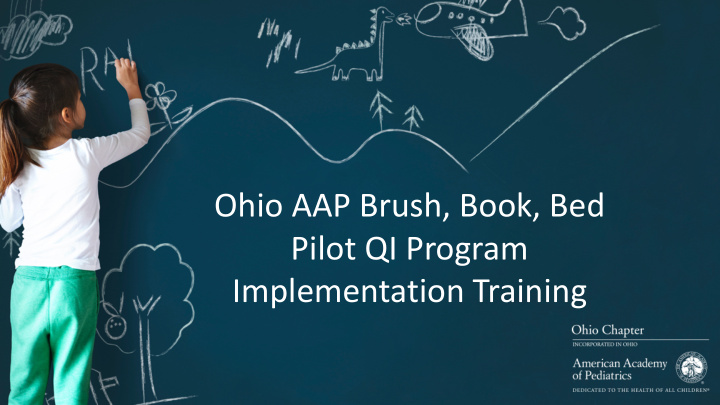



Ohio AAP Brush, Book, Bed Pilot QI Program Implementation Training
Measures/Goals MEASURE NAME TARGET CALCULATION Change in confidence score from pre-work to 85% of providers enrolled will report an post-project repeat survey collected by Participant Confidence Increase increase in confidence in discussion of conducting pre-work surveys at kick-off each individual BBB topic trainings and final surveys at exit interviews 80% of caregivers will have a discussion Charts with 1 of 2 oral health items Oral Health Discussion Attempted attempted documented / total charts reviewed 80% of caregivers will have a discussion Charts with 1 of 2 early literacy items Early Literacy Discussion Attempted attempted documented / total charts reviewed 80% of caregivers will have a discussion Charts with 1 of 2 sleep routine items Sleep Routine Discussion Attempted attempted documented / total charts reviewed 80% of caregivers will be offered Charts with provision of resources Resource Provision resources documented / total charts reviewed 50% of families will report learning Family Knowledge Increase something new about one BBB topic Collected on family feedback surveys during the visits
BBB Learning Collaborative AIM Interventions Key Drivers • Establish baseline data From December 2019 through • Measure documentation of June 2020, participants in the discussion, fluoride varnish BBB program will: Data Measurement and oral health/early literacy supplies provided - 85% report an increase in knowledge and confidence • Connection to Project Team from pre-test to post-test • Provider QI processes - 80% report attempted Resources • Provide materials (books, discussions on BBB topics at toothbrushes, etc.) WCV 6 months-6 years • Assistance with questions - 70% report sustained changes in activities on the 3 month • Learning Session/Training post project survey Education • Web-based resources • Monthly Action Period Calls • New resource notices from project team The Global Aim of the BBB project is to improve health Environmental • Office flow, implementation for Ohio children by changing Factors behaviors of pediatric Strategically enhance • healthcare providers around collaboration oral health, early literacy, and Payment for fluoride varnish • sleep routines.
MOC/Credit Expectations • Attend or review regional training materials • Conduct QI Implementation/Overview training • Data submission – Baseline and at least 4 months of intervention data • PDSA cycle worksheet submission – 3 total worksheets per practice • Action period call attendance – 1 representative from team on 4 of 5 calls • Complete post-project survey/exit interview in May/June 2020
Data Collection • All Data Collection Completed at 1 link: – http://ohioaap.org/bbbqidata/ – Data is for children six months – 6 years of age at time of well-child visits • Baseline data – 2 months (Fall 2019) – 5 charts/month per provider seeking credit (random selection) • Monthly data collection – By January 2020 – May 2020 – 5 charts/month per provider seeking credit (random selection)
Data Due Dates • January 13, 2020 - Baseline data and any December data • February 3, 2020 - January data • March 9, 2020 - February data • April 6, 2020 - March data • May 4, 2020 - April data • June 8, 2020 - May data
PDSA Cycles • 3 PDSA cycles to be completed during project • Due dates are – February 3, 2020 – March 9, 2020 – May 4, 2020 • Complete PDSA worksheet and scan/email or fax in • 1 PDSA worksheet per practice required
Action Period Calls • 3 rd Wednesday of each month • 12:15 – 1:00 pm • Hayley to send calendar request and webinar details • Dates (and tentative topics): – January 15 – Dental Homes – February 12 – Reach Out and Read/Early Literacy Resources – March 18 – Sleep related behavioral Health Concerns – April 15 – Sustainability of QI Projects – May 20 – Report Out
Family Feedback Surveys • To be provided: – At least anytime resources (handouts, books, toothbrushes, etc.) are provided – Goal of providing at every WCV 6 months – 6 years if possible • No patient identifying information collected • No data entry by the practice • Collect surveys and return to Ohio AAP by: – Fax: 614-846-6258 – Scan/Email to Hayley – Mail (will provide an envelope and UPS shipping label)
Resources to be provided by Ohio AAP • Books – maximum of 250 per month as supplies last • Oral health supplies – maximum of 250 per month as supplies last – Toothbrushes – Toothpaste – Fluoride varnish (upon request) • Project specific materials – Pocket guide (sent by January – possible PDSA #2 opportunity) – Handouts (sent by January) • When more supplies needed, contact Hayley – Supplies will be provided as available
Questions? • Next steps – mark your calendars for due dates and calls • Contact Hayley with questions/material needs • Beginning discussing topics/providing materials in visits • Plan PDSA cycle 1 – Idea: Using books/toothbrushes as a reminder to discuss topics
Recommend
More recommend